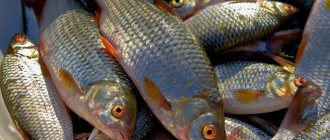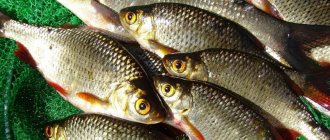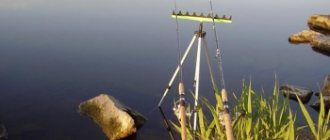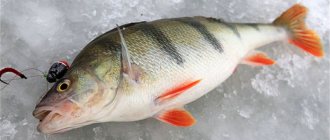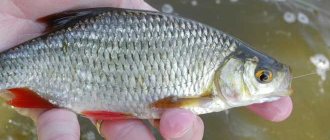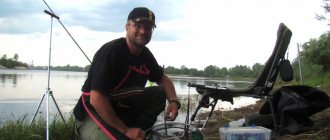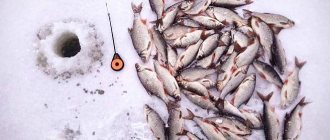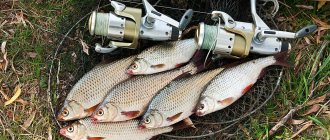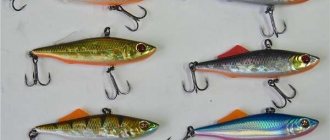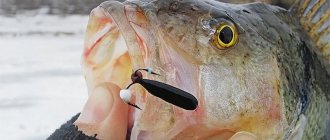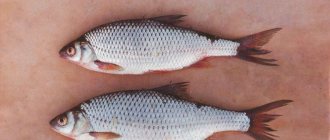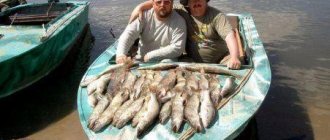Winter ice fishing is a challenging and interesting activity. Fishermen use all kinds of jigs as bait. If we are talking about catching roach, which is considered a capricious fish, then it is better to approach the choice of bait responsibly. The productivity of the fishery depends on a competent approach. Which jig is better, existing models and effective playing techniques is the topic of this article.
Roach caught on a green jig during winter
Selection criteria - what type and color does roach like?
Advanced fishermen who have considerable practical experience in catching roach in winter know which jigs to take. But for beginners it is more difficult in this matter, since the store assortment is so diverse that it leads to confusion.
It is recommended not to resort to the help of sellers, as they often offer products that remain unsold from last season. The following points need to be taken into account:
- what time of year the fishing will take place;
- anatomical structure of the mouth and lips of a fish;
- behavioral characteristics;
- type of reservoir.
On the shelves of fishing stores you can see many jigs, which differ in functionality and use. There are 2 key types of winter baits: reelless (not requiring live bait) and with bait. The first option is a priority for many, since it does not require spending time preparing the bait and placing it on the hook.
Only this method of fishing requires the appropriate knowledge and skill - it is unlikely to suit a beginner. Now it’s worth revealing other main characteristics of jigs:
- form;
- color;
- material of manufacture;
- weight.
There are no universally catchable jigs. The one that the fisherman learns to masterfully manipulate will be useful. Therefore, you need to stock up on several varieties.
Material
Can be made from any material. In this regard, manufacturers have wide scope for experimentation. Using different density alloys, they can vary the volume and weight of products. Traditionally, lead is used in production - an inexpensive and easy-to-melt metal. Such instances function well at medium levels.
Tungsten specimens are quite heavy, thanks to which they instantly reach the very bottom. Roaches bite on these in winter on the current in the bottom layers of the reservoir. For fishing in shallow waters, where there is complete calm, tin baits are suitable.
A variety of the most effective jigs for catching roach in winter
Form
The configuration is determined by fishing tactics. According to the indicator, they are divided into attached and non-attached. The first models are presented in the form of pellets or droplets. Used in combination with natural bait.
Mothless moths look like live food (bloodworms, maggots). All kinds of colored decorations add naturalness:
- cambrics;
- beads;
- Rings.
So even without a bait, the fish actively reacts to such a provocation.
Weight is an important point for fishing on a river with current
The weight is selected based on the intensity of water movement and the depth of the area where fishing will take place. This indicator affects the functionality of the nod. Therefore, you need to select them as a set. The table shows the relationship between bait weight and depth:
| Depth, m | Weight, g |
| 2 | 0,4-0,5 |
| Up to 4 | 0,5-1 |
| Up to 5 | 1-1,3 |
| More than 5 | 1,3-1,5 |
There are jigs weighing from 40 grams. Used for catching large underwater predators (for example, burbot). They are definitely not suitable for roaches.
Lure color
The colors of the attractive elements of the tackle play an important role when catching roach. Many experienced fishermen have noticed that this fish responds better to the following jigs
- colors:
- gold;
- silver;
- Dark red;
- bronze.
Sometimes atypical colors are productive: green, orange, and yellow.
The best bite occurs in cloudy weather with light-colored jigs; in clear weather, it is preferable to take dark baits.
Jigs for fishing on the first ice
For some, such a concept as “first ice” does not carry anything specific, but not for the fisherman. It is this phrase that means for him the beginning of real winter fishing, with all its features. In this article I want to tell you about what jigs are used on the first ice, for what types of fish.
First of all, I would like to draw your attention to the fact that at times, even during the first ice period, fish can be caught with varying degrees of success. It’s possible that it’s all about the unstable weather, or perhaps it’s about the bait itself. For some reason, the use of various colored beads and cambrics greatly improves the bite and the first ice is no exception. For example, perch is partial to jigs with yellow or white cambric. No-attachment jigs, which require shallow and fast play, have proven themselves to be quite good. Based on specific models, I can highlight the “Uralochka”, which catches perch well not only on the first ice, but throughout the winter. A drop jig is one of the best options for active perch at the beginning of winter.
Roach, in turn, prefers small jigs with red or pearl beads; tungsten pellets with a diameter of up to 3 mm are well suited. You can use small bloodworms or maggots as bait, or you can fish without them. As for baitless fishing, “nymphs”, “boats” and “ants”, most often of dark colors, are especially good here.
To catch bream during the first ice period, you can use such types of jigs as “inverted uralka”, “droplet” and “ovinka”, but not in too bright colors, which will probably only scare away the fish. Mothless ones are also used, they are especially good for reservoirs with rich fauna. By type, you can try “nymph”, “goat” and flat jigs. Don’t ignore hollow baits, which make a sound that attracts bream when they touch the bottom. As for baits, bloodworms, maggots, caddisfly and burdock moth larvae are used for bream.
For crucian carp it is better to take small jigs; “drop”, “disc” and “ball” are very popular. Here you just need to experiment with color. In general, I would advise you to start with light-colored lures, and then move on to brighter ones.
Also, during numerous experiments, it was a big surprise that during this period the average perch and roach eagerly grab jigs with two hooks. Many people have been using jigs equipped with tees for a long time, but they do not play very well with sharp jerks. Therefore, for fishing during this period, I advise you to buy or make your own jig with two hooks, and it is desirable that one of the hooks is slightly longer than the first. The bait will roll slightly from side to side.
At times it happens that a jig that worked successfully on the first ice last season practically stops catching in subsequent ones. The same thing happens in certain bodies of water. This can be explained by the fact that during the period of first ice, the level of illumination of the water remains at a fairly high level, so the color can greatly affect the results of fishing. It is definitely recommended to have a set of identical jigs of different colors with you.
Surely many are familiar with situations when, from the entire assortment of jigs, it is not possible to find something catchy. In this case, the so-called flat jigs, which are made of brass and their shape resembles a watermelon seed, will come in handy. These baits are used without bait; you can catch most types of fish with them, be it roach, perch or bream.
Additional elements that increase catchability
The effectiveness of catching roach with a jig is increased due to additional elements on reelless gear. This means all kinds of flashy decorations. It can be:
- pieces of colored electrical tape (cambrics);
- beads;
- feathers;
- beads;
- bright threads;
- chains and so on.
They are put on or attached to the shank of the hook. Due to this, during the game, an attractive background is created for the fish, which forces it to react even at a long distance.
DIY jig for roach
Many craftsmen who are keen on fishing make their own jigs. To do this, you will need any non-ferrous metal waste and other available materials. A few simple ways:
- The metal is poured into the finished mold, where the hook is first placed.
- The product is forged from an existing blank (usually lead), then a hook is soldered.
- The body is cut out using a file (hacksaw) and treated with sandpaper.
- Blanks are cut out of sheet metal, a hook is placed between them and connected with a soldering iron.
- A metal wire is wound onto the hook, creating a specific shape.
For a homemade jig, it is recommended to take hooks numbered 2.5 to 5. It is advisable to cover the finished specimen with several layers of paint (waterproof enamel or nail polish).
Video instruction:
Fishing technique and tackle
The first ice is quite thin, so drilling many holes throughout the entire area will not be difficult; this must be done quietly so as not to scare the fish. The holes should be small in size. For successful fishing, it is best to use a thin line with a jig; sometimes a good result can be achieved with the help of “sports” gear. But you shouldn’t often use such gear when fishing; it is most effective when catching live bait. When winter fishing on the first ice, you can use medium jigs. Moreover, the spoon provides a catch of perch and pike perch with a light bite. The most popular and productive jigs are called: “ovinka”, “eye”, “bug” and “nymph”. Dough can be used as bait. If the jig is simply lowered to the bottom, then there is a high chance that a roach will bite. Pay special attention to storing jigs. It should be wrapped in a damp cloth and stored in an enamel container.
Winter jig fishing is usually characterized by a quick bite, but sometimes in bad weather fishing turns into a long search for a good fishing spot. Having chosen a good place, you need to camouflage it. Everyone, even beginners, knows that there is no point in making noise. It is best to sit in a place lightly covered with snow or straw, because the fish can see a person through the transparent ice. Do not completely clear the cut hole of snow and ice so as not to frighten off its inhabitants. But the line must move freely, otherwise it will significantly affect the quality of fishing. Experienced fishermen advise starting fishing on the first ice with a jig. To protect the fishing line and the nod, a person should sit with his back to the wind. If you spot fry or small fish, be sure to prepare your fishing rod for the predator. Some fishermen place a bait nearby and prepare another spoon for big fish.
Don't forget about playing with bait. For example, perch bites if you play with it for a long time and actively. When winter fishing, the size of the balancer is most important, not its color. The first winter fishing is most successful with a fast technique of playing with bait and a large balancer. In case of bad weather, it is recommended to use the same equipment as in deep winter.
It is worth noting that a winter fishing rod is very different from summer fishing gear. It is very compact. The most common bait is the jig. It was invented by Russian fishermen. It consists of a hook and a sinker and can work independently.
The only trick that will help you if you fail in winter is to use a small jig. They lower it to the bottom and, periodically lifting it a couple of centimeters, move it. Afterwards they take a short pause, and then continue these actions.
Technique for catching roach with a jig
The quality and quantity of the catch depends on several factors. When fishing from ice in winter, pay attention to the equipment of your fishing rod. Also important is the playing technique, which determines the intensity of bites. You also need to know what to feed the fish and what bait to choose.
Winter fishing rod equipment
Tackle for catching roach in winter must be properly assembled. The thickness of the fishing line is chosen in the range of 0.07-0.15 mm, which will ensure better play with the jig. When planning to catch small or less active roach, preference is given to a smaller diameter. If you are going to fish in a reservoir, it is better to use thicker line.
Professionals advise beginners to use a fishing line no larger than 0.12 mm in diameter. When fishing at depth and in strong currents, it is less susceptible to tangling and snagging.
In the case of ice hunting for roach, there are no strict requirements for the rod and reel. The main thing is that these components are strong and reliable. As for the fishing rod, any frost-resistant float model will do. The nod is selected according to the weight of the jig - an acceptable size is from 5 to 10 cm. For particularly shy fish, longer nods should be used. Then, when playing, the jig will make smoother movements.
Now about the jig itself - it is selected depending on the depth of the lake (river), the strength of the current, weather conditions, fishing time and preferences of the prey. Before purchasing, you can consult with knowledgeable fellow hobbyists in order to buy products that have already been tested in practice.
If you play correctly, you don’t have to wait long for a bite
Which nozzle to choose
When jig fishing, bait should be prepared in the evening. The roach loves the following animals most of all:
- bloodworm;
- maggots;
- earthworms;
- burdock moth larvae;
- crayfish
An excellent bite occurs on the dough.
The best way to feed
Thanks to it, it is possible to attract a school to the hole - to arouse the interest of fish inhibited in the cold. There are many different industrially produced mixtures intended for both summer and winter fishing. All of them are effective in their own way, but need to be tested in practice.
For winter fishing, the bait should be crumbly
You can prepare similar compositions yourself at home. Here are the ingredients for one such recipe:
- breadcrumbs;
- ground fried buckwheat;
- pre-dried, crushed citrus zest;
- basil leaf powder;
- corn grits;
- ground peas;
- seasonings containing cinnamon or coriander.
Any flavorings should be added sparingly.
The prepared dry bait mixture should be moistened in advance with water taken from the reservoir (directly at the site of the upcoming fishing). Then the swollen composition is poured into the hole. It is important that the ingredients do not immediately settle to the bottom, but create cloudiness on the surface.
How to play with a jig
For those who are planning to catch roach from the ice for the first time and have bought several jigs, it will be useful to know several game options that provoke the prey to bite:
- Pulling with oscillations. The bait is sharply lowered into the hole until it touches the bottom. Then they slowly pull it up with periodic twitching of the nod. Every 20 cm take a break for a couple of seconds.
- Lifting the jig without oscillating movements. Wiring technically similar to the previous one. The only thing is that the bait is raised slowly so that it does not wobble too much. Periodic stops are also required.
- Wiring to the bottom. They raise it to a height of about a meter from the ground, then slowly lower it with minor fluctuations and delays. They act as in the first case, only in reverse.
- Knocking on the bottom. The jig is moved away from the bottom by 3-4 cm and sharply released so that it hits the bottom with force and muddies the space around it. They repeat this repeatedly, then freeze and wait for a while. If a roach is somewhere nearby, it will give a reaction.
Game techniques when catching roach from ice in winter
If perch is almost always located in the bottom zone, then roach can also settle in the middle water layers.
Sometimes he walks almost under the ice. If there is no bite for 30-40 minutes, although a promising place has been chosen, it is worth fishing the entire vertical.
Fishing rod equipment
On the first ice, there is no need to be particularly fine with the rigging of perch fishing gear and the size of the jig. Standard gear with fishing lines from 0.12 mm and baits from 0.3 grams is suitable, depending on the size of the fish. The setting is standard - the weight of the jig, the thickness of the fishing line and the elasticity of the nod are matched to each other. The more accurately the gear is adjusted, the more effectively it catches fish. Read more: fishing rod equipment for jigs
Working jigs for perch in the first ice
The debate about which jig is best for catching perch on the first ice will never stop. There is no need to look for the best jig - it doesn’t exist. In each specific case, a specific bait will work better or worse. It is possible to identify only general trends on which the fisherman bases his experiments on the reservoir.
- The best jig for perch on the first ice is the one that the angler correctly selected for these specific fishing conditions. More often, standard tungsten lures or lead soldering are used on a crown made of copper, brass, or silver steel. For small and medium-sized sailors, these are standard 3-5 mm baits weighing 0.2-1 grams, depending on the depth of the reservoir, the current and the preferences of the striped fish. There is no need to chase after all the variety of these baits lying on the shelves.
- It is enough for work to have a certain set of standard forms - droplets, oats, bugs, pellets. Then, while fishing in certain bodies of water, you can gradually catch and study others. But by and large, standard ones are usually enough - in a baited jig, fishing is primarily done with bloodworms or jigs, and the body of the bait is a weighting agent.
- In some bodies of water, light colors work better, in others - red, and in others - dark. For active perch, especially in shallow waters and in clear water, where the predator can see perfectly, it is better to start fishing with red and golden jigs, and for passive ones - with black jigs. Just start fishing, since only the fishing itself will show what will happen next.
- The hookiest jig is the ball, since due to its geometry, this bait has the longest hook in relation to the body. If tempo and speed of fishing are important, as in competitions, then you can switch to a shot for better detection. However, this is only advisable if the fish bites on every cast. In other cases, we simply use what works better as a result of experiments with baits.
Detailed article about the varieties of jigs for perch:
Attachment jigs
Tula tungsten
Mothless
Suspensions and tandems
Perch has a highly developed mode of food competition. A striped animal in an active state always tries to get ahead of its fellow and grab a piece. Therefore, for perch, including the first ice, various combinations of jigs with flies, silicone bubbles, or simply hooks with bloodworms, cambric in tandem above the main bait work well.
Pendants
You need to tie an additional provocateur at a distance of 10-30 cm on the main line, on a leash, with a locomotive, or simply by passing it through the line, limiting it with stoppers (knots, beads). Experimentation is also important in this matter - the pendants themselves, the distance to the lower jig, and the method of attachment are selected depending on the conditions and preferences of the perch. More information about flies for perch in winter
In such a combination, even during a pause, the light suspension still moves for some time, attracting perch. You can also specially give the equipment a slight shake in order to further animate the provocateur. All these manipulations are especially good when there is a perch, but it is not possible to catch it normally using standard methods.
Features of roach fishing in winter
Winter for fishermen is divided into periods. This is due to ongoing changes in the behavior of fish.
Fishing on the first ice
The first ice period is the time period from December to early January, when ice appears on the reservoir. This time is considered the most productive for fishermen. The fish becomes active and reacts to any bait and bait. Schools cluster near the surface and where vegetation is still present.
Fishing in the wilderness
In February, the dead winter begins, when the roach stops feeding. She becomes completely ambitious and becomes extremely capricious. Traditionally used fishing jigs are no longer effective.
Preparing for winter fishing
For successful winter jig fishing, you should carefully prepare. To do this, you can use the following tips:
- Even in the summer, you should look out for winter fishing spots, study the bottom topography well, and find the places where fish are most concentrated. It is worth looking for places for future fish parking at the end of July. At this time, the water level drops and it is easy to notice depressions at the bottom.
- If you have echo sounders and special navigators, you can examine the bottom for the presence of snags, stones and other relief objects.
- Any fisherman should have an ice pick in his arsenal, with which he will test the strength of the ice. The ice must withstand several strong impacts, then it can be considered more or less safe. But, in any case, do not forget about safety rules.
- A novice fisherman should begin training long before the start of the season. You need to purchase equipment, a tackle box and many other different devices.
Winter fishing on the first ice can rightfully be called the most productive. It is during this period that the fish begins to stock up on food, and therefore takes the bait with appetite. The timidity of fish and the clarity of the water are not an obstacle to successful fishing.
